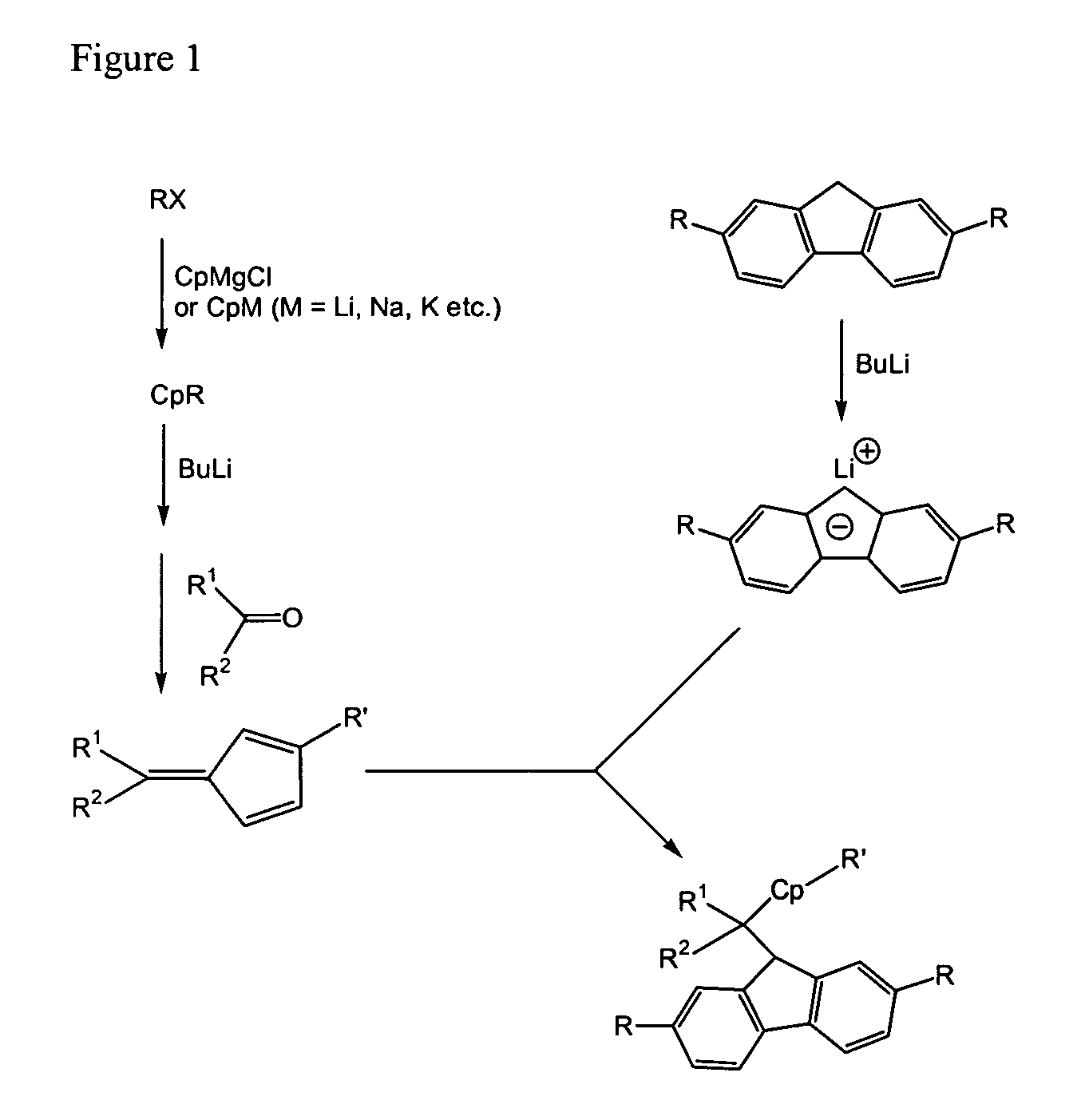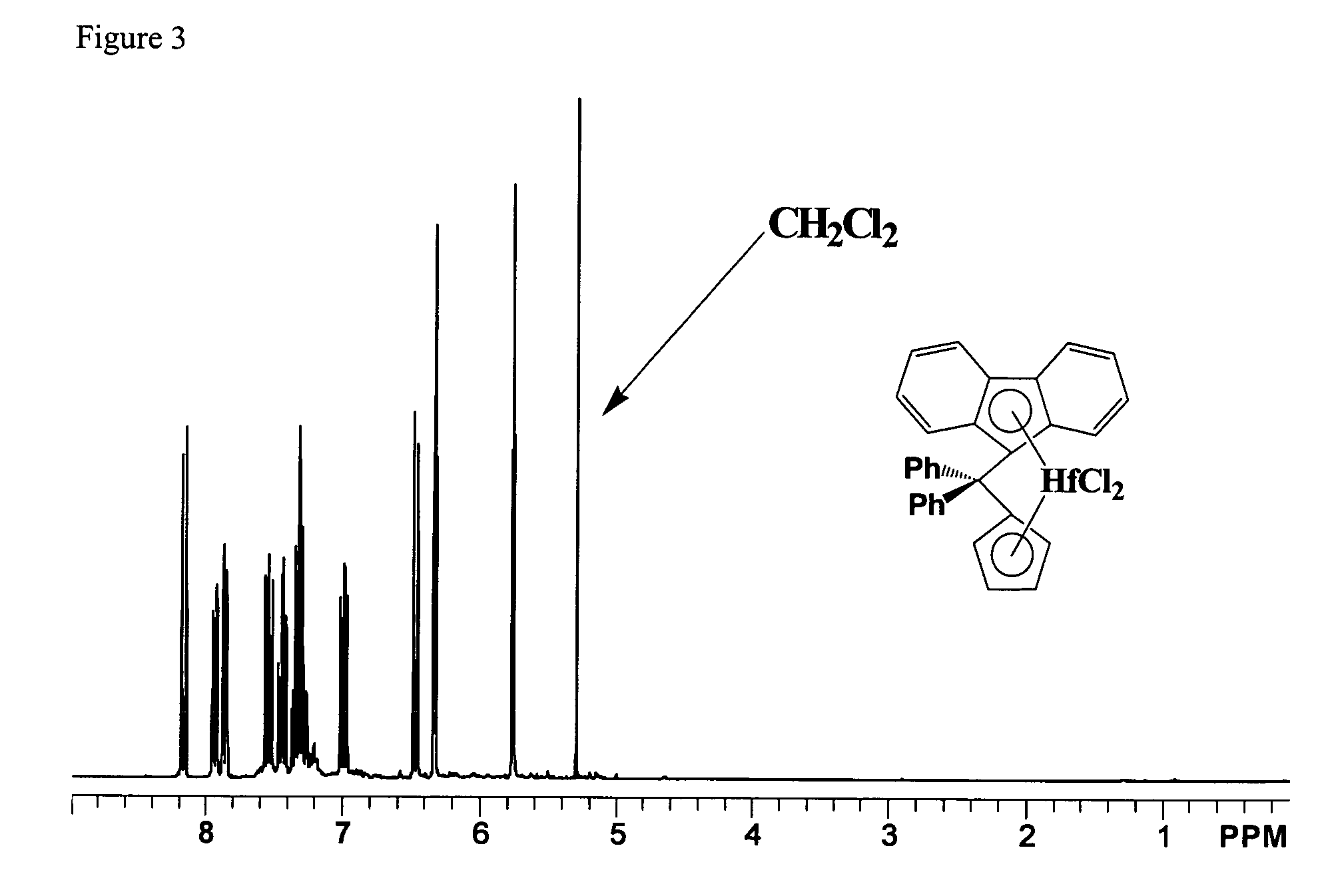Process for one-pot synthesis of 1,1-diphenyl-1-(3-substituted-cyclopentadienyl)-1-(2,7-di-t-butyl-fluoren-9-yl)methane type ligands
- Summary
- Abstract
- Description
- Claims
- Application Information
AI Technical Summary
Problems solved by technology
Method used
Image
Examples
##ventive example 4
Inventive Example 4
[0072]To 2,7-di-tert-butylfluorene (5.6 g, 20 mmol) dissolved in THF (30 mL) was added n-BuLi (2.1 mL of 10 M in hexanes, 21 mmol) at −78° C. The mixture was warmed to room temperature and stirred overnight. To above anion solution was added 6,6-diphenylpentafulvene (4.8 g, 21 mmol) dissolved in THF (20 mL) at 0° C. The mixture was warmed to room temperature and stirred for about 8 hours. To above reaction mixture was added 5-bromo-1-pentene (3.46 g of 95 wt %, 22 mmol) at 0° C. The mixture was warmed to room temperature and stirred overnight. The reaction was quenched with a mixture of ice-water. The mixture was extracted with Et2O. The organic layer was washed with saturated NH4Cl and water, then dried over anhydrous sodium sulfate. Removal of the solvent under vacuum gave a viscous brown oil as crude product. The crude product was purified by column chromatography with 5-10% CH2Cl2 in heptane. A mixture of isomers for desired ligand of structure (I), where R4A ...
##ventive example 5
Inventive Example 5
[0073]To 2,7-di-tert-butylfluorene (5.6 g, 20 mmol) dissolved in THF (30 mL) was added n-BuLi (2.1 mL of 10 M in hexanes, 21 mmol) at −78° C. The mixture was warmed to room temperature and stirred overnight. To above anion solution was added 6,6-diphenylpentafulvene (4.8 g, 21 mmol) dissolved in THF (20 mL) at 0° C. The mixture was warmed to room temperature and stirred overnight. To above reaction mixture was added 5-bromo-1-pentene (3.46 g of 95 wt %, 22 mmol) at room temperature. The mixture was refluxed at 70° C. for about 3 hours. The reaction was quenched with a mixture of ice-water. The mixture was extracted with Et2O. The organic layer was washed with saturated NH4Cl and water, then dried over anhydrous sodium sulfate. Removal of the solvent under vacuum gave a viscous brown oil as crude product. The crude product was purified by column chromatography with 5-10% CH2Cl2 in heptane. A mixture of isomers for desired ligand of structure (I), where R4A and R4B ...
PUM
 Login to View More
Login to View More Abstract
Description
Claims
Application Information
 Login to View More
Login to View More - R&D
- Intellectual Property
- Life Sciences
- Materials
- Tech Scout
- Unparalleled Data Quality
- Higher Quality Content
- 60% Fewer Hallucinations
Browse by: Latest US Patents, China's latest patents, Technical Efficacy Thesaurus, Application Domain, Technology Topic, Popular Technical Reports.
© 2025 PatSnap. All rights reserved.Legal|Privacy policy|Modern Slavery Act Transparency Statement|Sitemap|About US| Contact US: help@patsnap.com



